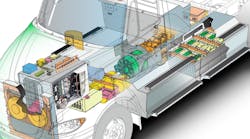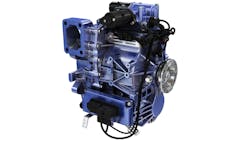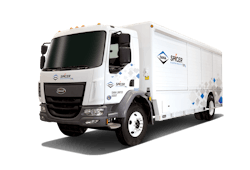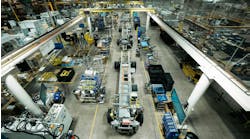Electric trucks remain in their infancy. There is limited real-world data and more questions than answers when it comes to everything from charging infrastructure to the total cost of ownership of these vehicles.
Yet rarely a day goes by without an announcement of an industry partnership or government program aimed at accelerating the adoption of electric trucks. It is bringing together many of the original equipment manufacturers and component suppliers that are already developing electric buses and other vehicles—experiences helping to create the powertrains of the future for freight transportation.
“Electromobility is happening now,” said Peter Voorhoeve, president of Volvo Trucks North America, sparked by societal challenges of air pollution, noise pollution, and the greater utilization of sustainable energy sources.
“Interest for [electric vehicle] offerings is very high right now, with essentially all OEMs developing vehicles in the various spaces,” said David Genise, product strategy manager of eMobility systems at Eaton Corp. “The market pull is uncertain, but all manufacturers want to be ready to offer products in their respective strongholds.”
Genise spoke with Fleet Owner in August, prior to Daimler Trucks North America delivering its first all-electric, Class 8 Freightliner eCascadias to customers for real-world use.
Volvo delivered its first electric trucks for testing in Europe earlier this year. The company plans to begin building electric trucks for the North American commercial vehicle market starting in 2020, and it is working with Samsung SDI and other partners to grow its electromobility capabilities.
Peterbilt Motors is developing multiple medium-duty, all-electric models, and Kenworth Truck Co. and Toyota Motor North America are collaborating to develop zero-emission Kenworth T680s powered by Toyota hydrogen fuel cell electric powertrains.
Mack Trucks unveiled the LR battery electric vehicle at Waste Expo this past April, with testing planned with the New York City Dept. of Sanitation, while Navistar Inc. also intends to introduce a medium-duty electric model based on the International MV Series.
“Advancements in battery and driveline technologies, and real-world vehicle deployment, are helping fleets become more comfortable with the accelerated pace of the transition” to electric vehicles, said Steve Slesinski, director of global product planning for Dana Inc.
While tighter emissions regulations at the federal level and from the California Air Resources Board will require greater adoption of electric vehicles during the next decade, Volvo’s Voorhoeve said purchasing incentives for vehicles and charging infrastructure are needed now to help make electromobility easy and cost-effective.
“The industry is anticipating expansion of favorable use cases of electric vehicles in all sizes of commercial vehicles,” said Genise. “The first applications for electric trucks are in the light- and medium-duty sectors, generally in hub-and-spoke operations, which have low-mileage predictable routes,” including vehicles that start and end their day at central locations.
Local delivery and port drayage are among the other sectors likely to transition first, added Genise.
Similarly, Slesinski told Fleet Owner that depending on customer duty-cycles, battery electric and hybrid solutions can be cost-justified now. However, he also cautioned full battery-electric vehicles may not be the ideal choice for every commercial vehicle application.
“In particular, Class 8 vehicles that can travel 400-500 miles per day and have varying routes and payloads are unlikely to make a rapid shift to electric drivetrains,” Slesinski explained.
Instead, a move to hybrid technology could be a good approach for a variety of long-haul vehicles, he said.
Earlier this year, Dana set a strategic partnership with Hyliion Inc. to expand its ability to offer complete diesel-electric hybrid systems. Hyliion develops electric-hybrid architectures for Class 8 vehicles that can be installed on new trucks or retrofitted on existing trucks, essentially turning a traditional 6x2 truck into a 6x4 hybrid.
Dana’s electric portfolio includes Spicer Electrified direct drive systems, as well as fully integrated e-axles, equipped with the TM4 motors, inverters, and control systems.
Dana also recently completed its acquisition of Nordresa, which Slesinski called “one of the most significant acquisitions we have made in the EV space as it allows us to provide fleet and OEM customers with complete battery electric vehicle solutions.”
Meritor Inc. is working on more than 20 electrification programs around the world and expects to have at least 130 fully electric medium- and heavy-duty trucks on the road by the end of next year. It is beginning to deliver the third-generation 14Xe all-electric axle to customers, to offer more power and smoother shifting, said T.J. Reed, vice president of electrification.
In 2018, Meritor announced the launch of Blue Horizon, a new technology brand representing the company’s emerging platform of advanced technologies centered on electric drivetrain, efficiency, and connectivity systems.
Its all-electric drivetrain systems are being tested in several vehicle platforms designed for regional freight, local delivery, and garbage collection through an alliance with TransPower.
Similarly, this year Eaton combined its electrified vehicle products into a single business unit called eMobility.
Eaton’s medium-duty 4-speed transmission is available for production, which Genise said works with smaller, less expensive motors to deliver uncompromised gradeability and acceleration expected of trucks and buses.
In Classes 7-8, Eaton is developing a heavy-duty, 4-speed transmission. Prototypes will be in vehicles on the road before the end of this year.
Elsewhere, Allison Transmission is working with numerous partners as its rolls out its AXE Series, which features electric motors, a 2-speed gearbox, oil coolers, and pumps. The electric powertrain will be integrated into the Model 579EV electric Class 8 truck for evaluation and testing.
Allison said the AXE Series is one of the most powerful e-axle systems for medium- and heavy-duty trucks and designed to fit inside a standard frame along the axles of commercial trucks.
“The AXE Series is the first e-axle in the heavy-duty truck industry to provide this level of power density, size and simplicity,” said David Graziosi, president and CEO of Allison Transmission.
The company also recently purchased Vantage Power and AxleTech’s electric vehicle systems division to expand its growing capabilities in the electrification space.
In 2017, Cummins Inc. unveiled the AEOS, a demonstration truck that uses a 140 kWh battery pack instead of a 12-liter engine. The day cab has a gross vehicle weight rating limit of 75,000 lbs. when paired with a trailer.
The truck represented a further step into the electrification space across the globe, aided by numerous acquisitions, including Johnson Matthey Battery Systems and Brammo.
More recently, the company has started delivering eight all-electric vehicles to the U.S. Postal Service, and it was selected by Kalmar to be the electrification solution provider for the electric terminal tractor for the European market.
Cummins is also among many of the companies taking steps to prepare for the potential waste created by the shift to electromobility. In August, Cummins announced a multi-year partnership with the University of California-San Diego and its battery validation lab to analyze business and technical approaches to effectively reuse and repurpose electric vehicle batteries. UC-San Diego will perform testing and develop an outdoor second-life demonstration system comprised of Cummins battery modules.
“Electrification has the potential to play an enormous role as we move toward decarbonization of many industries, but in order to maximize that potential, it’s crucial that we focus on the sustainability of the entire product life cycle,” explained Julie Furber, vice president of electrified power for Cummins. “One piece of the puzzle that requires additional research is the second life of batteries.”





